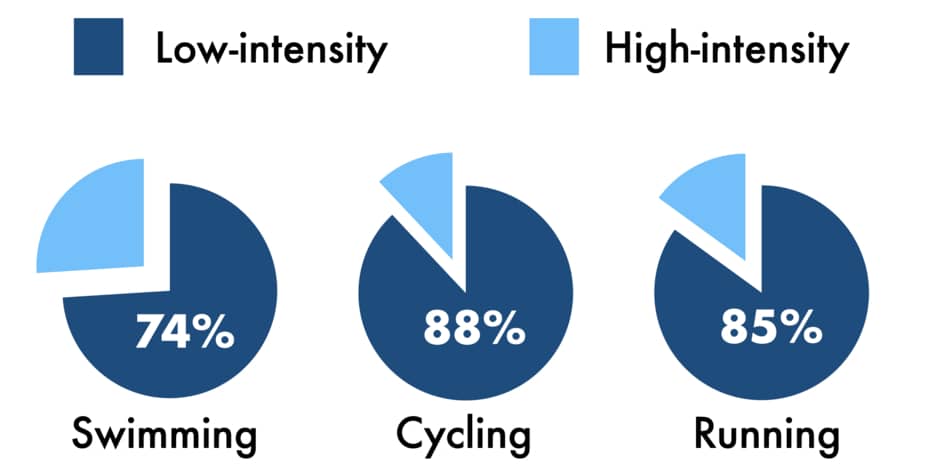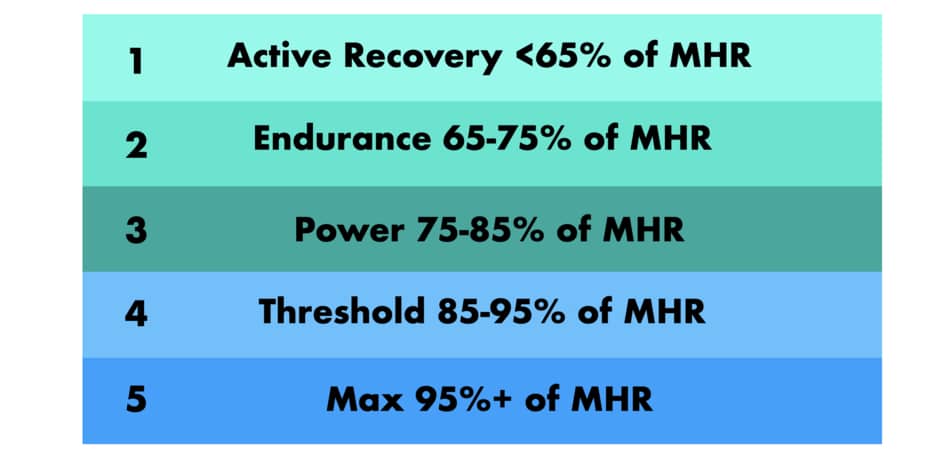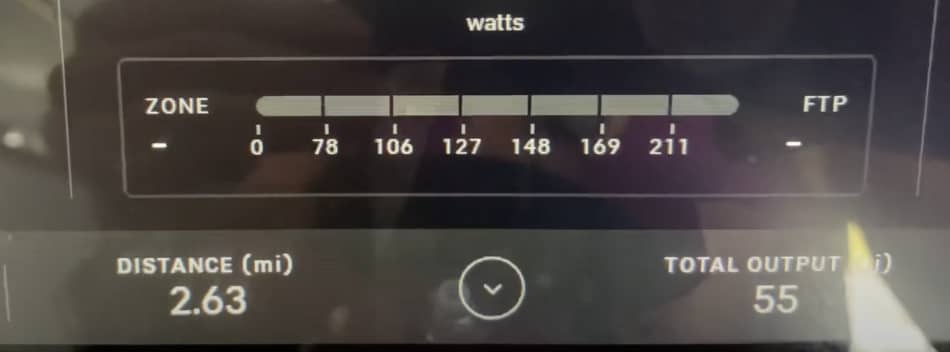If you train for a triathlon then following a reasonable plan that includes periodization strategies and the right work/rest ratio is important.
In this article, I will explain if peloton is good for triathlon training and if so, which classes should you do.
As a whole, the peloton is good for triathlon training because it allows you to sustain high training volume with various combinations of intensity. It also has a built-in power meter with an FTP score that allows for measuring the intensity and monitoring the training load for each session.
Keep reading to learn how to use a peloton bike to design a well-balanced triathlon training program to ensure peak performance for cycling, as well as running and swimming.

First, let’s talk about Peloton triathlon training
Overall, you can train for a triathlon on the peloton bike because it has thousands of cycling classes, which can be used throughout all training seasons.
It also has several recovery rides, which can be used during tapering time.
Does Peloton have a triathlon training program?
As a whole, the peloton doesn’t have a designated triathlon training program.
However, it does have marathon and 5K training programs, as well as cycling power zone programs where you can improve your FTP score and build up aerobic capacity.
Spinning does help with triathlon training because it builds up muscular endurance, as well as transfers adaptations to other training modes.
A triathlete’s running performance can improve from cycling workouts and vice versa, which is referred to as the interference effect.
In other words, doing a variety of sessions on the bike will have a positive impact on the performance of the rest of the triathlon disciplines (running and swimming).
However, studies have shown that cross-transfer training effects occur most between cycling training and running performance, and less in swimming.
That’s because swimming is a highly specific activity, which does not benefit from doing cycling or running (Millet et al. 2002).
Nevertheless, please remember that Peloton also offers a range of strength training classes, which does improve swimming performance (more on that later).
Here are the best peloton classes for triathlon training.
Best peloton classes for triathlon training
1. Power Zone Endurance Ride
Power zone endurance ride is a class where you train at zones 2 and 3, which is referred to as aerobic threshold. Those classes work by focusing on training at low-to-moderate intensities.
This class is good for triathletes because it maintains its effort level just below the lactate threshold.
Low workout intensity allows training multiple times per week (10 to 13) while minimizing the risk of negative training outcomes.
The majority of studies have shown that optimal training for endurance uses the 80/20 rule, which means 80% of training sessions are performed at low intensity.
The 80/20 triathlon training method, also called polarized training, is widely used by top-level swimmers, rowers, runners, and triathletes.
For example, one study has documented a training program for a world-class female triathlete preparing to compete in London Olympic Games 2012.
Her training plan took 50 weeks and included:
- 796 total sessions
- 303 swimming sessions
- 194 cycling sessions
- 254 running sessions
- 45 strength training sessions
The most fascinating about her triathlon training plan was that over 80% of the training sessions were done below her lactate threshold.

In the graph above you can see the percentage of training sessions that were done in the low-intensity threshold.
224 swimming sessions, 170 cycling rides, and 215 running sessions were done in the low aerobic zone.
What I like about the peloton bike is it has a built-in power meter.
After you take the peloton FTP test, you will immediately unlock the power bar, which allows you to monitor your current intensity.
Which peloton power zone is best for triathlon training?
Overall, zone 2 and 3 are the best power zones to train for the triathlon because they are performed just under the lactate threshold.
Using the power zone endurance ride helps to train and control training intensity throughout the entire season.
2. Heart Rate Zone Endurance Ride
The Peloton heart rate zone endurance ride is the alternative to the power zone ride.
The difference between HRZ and the power zone is that the heart rate zone uses a heart rate monitor as an effort level measurement.
Heart rate is one of the most common ways to assess training intensity, together with a rating of perceived exertion (RPE) or oxygen consumption using indirect calorimetry.
The peloton heart rate zone endurance ride is good for triathlon training because most of the class is performed at the 69-83% maximum heart rate.
This heart rate zone refers to “endurance” and allows one to train for multiple hours, without causing excessive fatigue.
What heart rate zone should I train for a triathlon?
In short, the best heart rate zone to train for a triathlon is between endurance and aerobic capacity.
This is equivalent to 140 to 150 beats per minute and between 75-85% of your average heart rate.
Here you can see the 5 heart rate zones on the peloton.

As much as heart rate training is well-documented, recent research shows that estimated maximal heart rates are too variable to be used as a guide for training pace during cycling.
Several factors can influence the variability of the heart rate on a day-to-day basis:
- Heart rate adaptation – Long race can lower the heart rate while maintaining the same effort level.
- Poor recovery – Not getting enough rest/sleep can increase the heart rate and suggest altering training intensity.
- Nutrition – Eating certain foods changes the blood flow and can trigger higher heart rate, as well as blood pressure.
That being said, heart rate monitors are still viable tools to use in triathlon training, especially during outdoor cycling and running.
3. Power Zone Max Ride
Apart from low-intensity rides, the peloton also has several high-intensity sessions that complement the triathlon 80/20 rule.
Power zone max ride is all about training at the highest effort level, usually by gradually increasing the power output to reach zones 6 and 7.
The peloton power zone max ride is effective for triathlon training because it allows training above the lactate threshold.
Those sessions are designed to improve VO2 max, power, and speed.
They also mimic the race pace intensity.
In this session, you can expect to train above your 90% maximum heart rate.
What I like about the power zone max ride is it uses multiple variations of interval training.
This helps to reach maximum power output for a short time, followed by the recovery time.
The good news is that you don’t have to prioritize those sessions in your training plan.
As you remember, the 80/20 rule allows you to only spend 20% of your time going above the OBLA (onset blood lactate accumulation) threshold.
Also remember that power zone rides use a power bar, which makes it easier to track your intensity.
You can see the peloton power bar on the bottom of your screen.

Other peloton classes to use during your 20% time that are equally hard are:
- Tabata Rides
- Intervals Rides
- HIIT Ride
- ProCyclist Ride
4. Recovery Ride
Some elite endurance athletes spend 16 hours per week training for the whole 12 months.
With so much training load, an Integrated periodization approach with sufficient recovery and tapering time is essential to prevent excessive fatigue and injuries.
Taper in triathlon is part of training periodization where the training load is reduced for a few days before a major competition.
Tapering restores optimal levels of muscle glycogen, enzymes, and hormones, which results in better race performance.
The recovery ride is important in triathlon training because it enhances the rest time by adding active recovery.
These rides are performed with minimum intensity and short 20 minutes duration, which is enough to increase muscle perfusion and enhance lactate clearance.
What’s the difference between taper and recovery days?
As a whole, the difference between taper and recovery days is that taper often takes 5 to 14 days and it’s done just before the race.
The recovery days can be done multiple times during the training season, usually one day per week.
Here are some tips for using the peloton recovery rides for triathlons, according to USA Triathlon Team.
- Take a rest day every week – The idea of taking a recovery day is to reduce your training to a minimum. You can still do some active recovery.
- Take a rest week every three or four weeks – This allows to maximize the benefits of recovery. You should also reduce your training volume during that week.
- Quality is more important than quantity – Getting enough sleep is not enough to recover. Lowering or even skipping the entire day of training goes beyond 7 hours of sleep.
Best Peloton Tread Classes For Triathlon
Overall, running is considered the most important part of triathlon training, depending on the length of the race.
Studies have shown that faster overall times were correlated with faster running.
Also, running and cycling take up 90% of the total triathlon time.
The triathlon training on the peloton tread is effective because it allows you to control training intensity.
By adjusting the speed and incline you can choose to train within the desired heart rate zone, wherever that’s low or high intensity.
It also makes it easier to plan your macrocycles, mesocycles, and microcycles blocks.
Running outdoors is great, but unless you don’t have strong body awareness, it can be difficult to track and adjust to your intensity level.
What I like about peloton tread is it has hundreds of different classes, and it allows you to use “just run” mode and follow scenic rides.
5. Walk + Run
Peloton walk + run classes are perfect for doing the majority of the low-intensity triathlon training, especially for beginners.
This type of workout was popularized by Jeff Galloway and his run-walk-run marathon training method.
It works by alternating running with walking, as soon as you notice your heart rate is going too high. This helps to control the intensity and extend the length of the running session.
The peloton run plus walk class is effective for triathlon training because it lowers the intensity and allows one to do higher distances.
It also leads to fewer injuries as during the walking you can realign and correct the posture.
The ratio of walking to running will depend on your fitness level.
I think this class is the perfect way to ramp up the training volume, especially if you want to train a couple of times per day.
Doing a walk + run helps to stay on track with your training schedule.
By the way, the peloton has almost 200 different walk plus run classes that vary in duration, intensity, and walk/run ratio.
This means you can easily find the class that suits your current fitness level.
The longest class takes 60 minutes and is led by my favorite peloton endurance coach, Matt Wilpers.
6. Endurance Run
A Peloton endurance run is very similar to a power zone endurance ride but without a power meter.
This means you need to monitor your intensity with a heart rate monitor.
This class is good for triathlon training because it allows you to stay at the lower end of the heart rate training zone.
Each class has a steady-state tempo where you don’t go above the aerobic threshold.
This way you can sustain high training loads, and build stamina, and an aerobic foundation.
This is the same 80/20 rule that applies to cycle training.
Slow and steady wins the race.
7. HIIT Run
Peloton HIIT run is parallel to HIIT and Tabata rides.
It’s about building the anaerobic capacity and training above your lactate threshold.
The peloton HIIT run is effective for triathlon because it trains at a high intensity and elevates your heart rate.
It also has a short 20 minutes duration, which is enough to maximize the training adaptations, without overtraining.
Let me be clear, 20 minutes of HIIT run is enough to improve your performance.
Please remember that training for a triathlon does require hours of training, sometimes even three times per day. But to prevent fatigue and burnout you need to focus more on easy runs.
Learn more: Click here to learn more about “best peloton postpartum classes“.
Best Peloton Strength Classes For Triathlon
Peloton strength has over 2,000 classes that can be used in a well-planned and periodized weight training program to complement triathlon training.
As a whole, you should do peloton strength for triathlon because it helps with long-term development, improves performance, and minimize the risk of injury.
The strength classes for triathletes should include a lot of power, plyometrics, and explosive movements.
Strength training is important because it helps to improve full-body strength which translates into a greater ability to generate force during swimming.
It also improves pedal stroke, as well as posture during running.
In other words, strength training makes you stronger at everything else.
Does peloton strength help with endurance?
In short, yes.
Peloton strength does help with endurance training because the classes contain multiple exercises that work on both muscle strength and muscle stamina.
Those include squats and lunges.
They also include explosive exercises like burpees and jumps.
Triathletes should train at least once a week for 30 to 60 minutes with resistance training.
Adding strength workouts to your plan not only helps to increase power output but also allows you to train at higher intensities.
Here are the best peloton strength classes for triathlon.
Full Body Strength
Peloton full-body strength allows you to hit all the biggest muscle groups in one session.
This way you save time and can focus on the most important part, which is endurance training.
Don’t get me wrong, split training where you divide days into different body parts is effective, especially for fat loss because it stimulates greater muscle protein synthesis than full-body.
However, doing split training means you would need to do 4-5 strength sessions each week.
This would shave off a significant amount of time from your other sessions, not to mention compromise recovery.
Overall, the peloton strength is good for triathlon training because it uses heavyweights with a rep range of 8 to 10, as well as includes all the necessary compound movements like:
- squats
- pushups
- rows
- lunges
- deadlifts
It also includes many core and stability exercises.
Ideally, you would want to use heavyweights in the gym to complement your triathlon training.
Strength and power don’t come from doing light weights. It comes from heavy lifts done for 3-5 reps.
However, the peloton’s full-body strength is the next best option.
Peloton Triathlon Training Tips
Here you can see some of the best tips for triathlon training.
1. Focus on Intra Wokrout
Intra workout is a concept of fueling your body during training time with carbs and proteins.
This allows for maximizing muscle protein synthesis and reduces cortisol.
Intra-workout is important in triathlon training because it helps to rapidly replenish muscle glycogen and elevate insulin levels.
High insulin during the endurance workout helps to carry glucose, amino acids, and other nutrients into the muscles, as well as lower cortisol.
High cortisol not only suppresses the IGF-1 hormone but also enhances muscle protein breakdown (Christiansen et al. 2007).
Here are some other benefits of intra-workouts:
- Lowers catabolic hormones like glucagon, epinephrine, and cortisol.
- Increase muscle protein synthesis.
- Decrease muscle protein breakdown.
- Facilitate quicker and more effective recovery.
By the way, you don’t need a lot of carbs during the training.
Studies have shown that the best form of carbs to be taken during the endurance workout are types of high-molecular-weight maltodextrin called highly branched cyclic dextrin (Furuyashiki et al. 2014).
2. Protect Your Sleep
Sleep hygiene is essential in any recovery practice, especially in triathlon training.
One bad night’s sleep can set you back for the entire day of training, which can have some psychological effects.
Sleep management is important in triathlon training because it dictates how well your body recovers from the high-volume training.
It will also influence your performance and ability to run or cycle for longer.
Learn more: Click here to learn more about “can peloton cause plantar fasciitis“.
Conclusion
As you can see, the peloton is versatile equipment. It can be utilized to help you train for a triathlon at all stages of your training season. Above all, I think the biggest advantage of the peloton is the ability to train in a variety of ways, without leaving your home.
